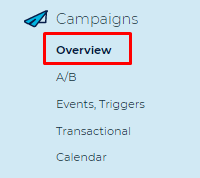
Table of Contents:

The quickest way to get a quick overview of delivery and performance stats for a given campaign is from the the Campaigns → Campaigns Overview page.
For "Completed" campaigns go to the 'Actions' column and click on the Snapshot Report icon.

A new pop-up window will appear showing an overview of that campaign's delivery and performance statistics.
For a fully detailed report of campaign stats – see the Aggregate Report below.
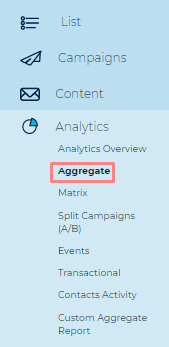
First and foremost, the Aggregate report provides a campaign level grouping analysis:
You can see there your full email delivery stats funnel: sent, success to failed, hard bounces and soft bounces per campaign.
You can also view all unsubscribed and complaints aggregated per campaign.
Finally you can also view all behavioral performance stats including: opens, clicks along with any behavioral conversion points you might be using.
![]() Note: Due to Gmail caching image open stats could be lower that other ISP/Domains.
Note: Due to Gmail caching image open stats could be lower that other ISP/Domains.
Per Day: shows delivery stats in per day grouping.
Per Week: shows delivery stats in per week grouping. ![]() This grouping is good for identifying trends of soft bounce rates, open rates, hard bounce rates, unsubscribe rates, etc.
This grouping is good for identifying trends of soft bounce rates, open rates, hard bounce rates, unsubscribe rates, etc.
Per Month: shows delivery stats in per month grouping. ![]() This grouping is good for identifying trends of soft bounce rates, open rates, hard bounce rates, unsubscribe rates, etc.
This grouping is good for identifying trends of soft bounce rates, open rates, hard bounce rates, unsubscribe rates, etc.

Per Country (Geo) stats: shows open and click stats grouped per country and continent

Note: The information for each open (or click) is stored separately, if a contact clicked once from UK and once from FR, he will have two separate open entries and subsequently appear in both segments (UK openers and FR openers). Same goes for statistics.
![]() Note: Due to Gmail caching images, the open may appear under the location of their caching server (often in the US), and not where the email was actually opened.
Note: Due to Gmail caching images, the open may appear under the location of their caching server (often in the US), and not where the email was actually opened.
Per Browser stats: shows opens and clicks grouped by recipient browsers including mail clients like Apple Mail, Outlook, Chrome, IE, etc.
Per OS stats: shows opens grouped by recipient operating system. E.g., Windows, MaxOSX, iOS, Android, WinPhone
Per Tag: You can tag your emails with a label (similar to tags and labels you might find in: Gmail, Blog Posts, Photo Management software, etc. See here for more about Tags in general). You can then get stats across multiple campaigns using these tags.
Per Link Group: If you're using Ongage Link Groups, then in this tab, you'll get an aggregated report showing all clicks per Link Group.
Per Email Name / ID: Delivery (sent, success, bounces) and performance (opens, clicks) stats, grouped per email message name and email message id.
Per Email Subject: Delivery (sent, success, bounces) and performance (opens, clicks) stats, grouped per email subject.
Per From (Email) Address: Delivery (sent, success, bounces) and performance (opens, clicks) stats, grouped per from-name email address.
![]() Ongage Analytics date filters are by "Stats Date" (and not schedule date). So for example if you filter for the last 2 weeks in aggregate report, it will show all campaigns scheduled in last 2 weeks, as well as any campaign from earlier sent dates, that have accumulated new open, click, etc. stats, in the past 2 weeks. Those latter campaigns will have sent stats of 0.
Ongage Analytics date filters are by "Stats Date" (and not schedule date). So for example if you filter for the last 2 weeks in aggregate report, it will show all campaigns scheduled in last 2 weeks, as well as any campaign from earlier sent dates, that have accumulated new open, click, etc. stats, in the past 2 weeks. Those latter campaigns will have sent stats of 0.
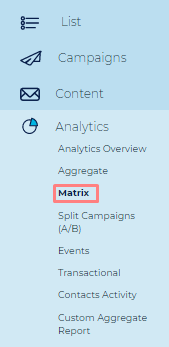
The ongage Matrix report enables viewing and analyzing deliverability (sent, success, fails, soft bounces, etc.) and performance stats (opens, clicks, unsubs, etc.) grouped by the ISP domains (aka Internet mailbox providers e.g., Gmail, Yahoo, AOL, Outlook.com, etc.) that you sent to in your list. Moreover it provides important insights into your IP and sending domains reputation, associated with the sending vendor connections used to send to those ISP mailbox domains. |
The report offers 2 views:
Grouped by ESPs/SMTP vendor connection (aka ECID). Associated with each vendor connection is an IP and Sending domain.
Grouped by the top Domains aka ISP/Mailbox provider domains.

Here you'll find delivery and performance KPIs for the top largest 7 ISPs you're sending to. If you would like to see the full long tale, to go to the Custom Aggregate Report detailed in one of the following sections.
The Matrix report enables email marketers to analyze and thus optimize their email marketing delivery and performance!
![]() One of the most important analytics this reports provides is idenitrying ISP domains with delivery and soft bounce issues – a strong indication of either sending domain or IP reputation! Thus enabling marketers to take direct and immediate action to repair, for example: slow down sending to that ISP mailbox domain, and rebuild IP and sending domain reputation to it, by making sure to send only to your most engaged contacts of those ISP mailbox domains.
One of the most important analytics this reports provides is idenitrying ISP domains with delivery and soft bounce issues – a strong indication of either sending domain or IP reputation! Thus enabling marketers to take direct and immediate action to repair, for example: slow down sending to that ISP mailbox domain, and rebuild IP and sending domain reputation to it, by making sure to send only to your most engaged contacts of those ISP mailbox domains.
![]() Note: Due to Gmail and IOS 15 image caching, open stats may vary and may be less reliable.
Note: Due to Gmail and IOS 15 image caching, open stats may vary and may be less reliable.
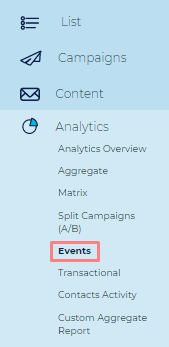
Events statistics appear under the sub-menu of Analytics. Stats are grouped by specific events and for each event you can get a drill down report for each one of its triggers and trigger instances. You can analyze Event analytics by grouping them as First Level and Second Level using the following filters.
Event: It is the Event ID that is visible in the UI.
Trigger: It shows the associated Trigger ID.
Trigger Instance: When each trigger is run, an instance of that trigger is generated which is known as Trigger Instance.
Email Message: The message that is to be sent associated with the event.
Stats Day: When you open the sent mail on a particular day, you will receive the stats for that day.
Send Day: The day when the mail is sent.
![]() Important note: you'll want to make sure, that the date filter, reflects the dates of the stats you wish to review.
Important note: you'll want to make sure, that the date filter, reflects the dates of the stats you wish to review.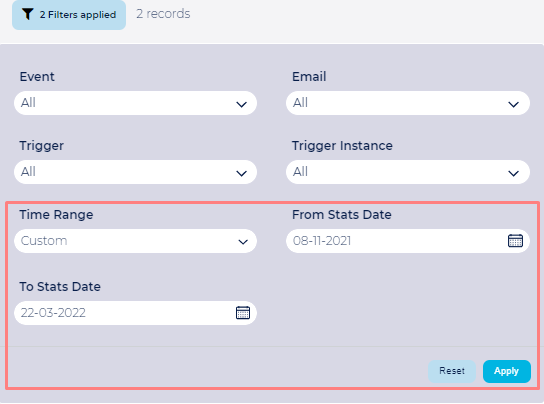
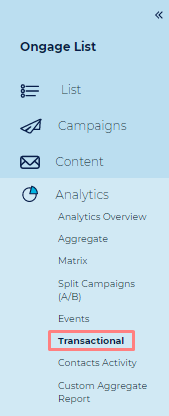
Transactional emails statistics appear in the transactional sub-menu under Analytics. You can review there the stats for all Transactional emails sent (including List welcome emails and other API transactional mailings).
Those can be viewed in the Matrix report (see above). The Campaign Filter allows you to filter the stats by:
Regular campaigns
Event campaigns
Transactional campaigns
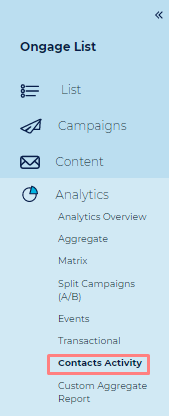
Contact Activity Report
|
![]() Note: When you choose the campaign filter, it will only select contacts that participated in the selected campaign(s) and will provide stats only for those selected campaign(s) taking into account also the required time-frame filter.
Note: When you choose the campaign filter, it will only select contacts that participated in the selected campaign(s) and will provide stats only for those selected campaign(s) taking into account also the required time-frame filter.
Click on the Search Contact Activity button.

Select a Segment, Campaign, or any other set of contacts (including a specific email address, or email is not empty) to generate a report, that will appear in the Report Dashboard at the top of the list. ![]() It is very important to select the time-frame you want the contact activity to cover.
It is very important to select the time-frame you want the contact activity to cover.

![]() For all contact activity in the list for the previous day, select email is not empty, and yesterday’s date:
For all contact activity in the list for the previous day, select email is not empty, and yesterday’s date:

Click on the ‘View Report' (as seen in the screenshot above) for an aggregated report with a summary of all sends, opens, and clicks per contact, in the given stats time range you chose. Here you’ll also find deactivation dates as well as the last sent, and last opened dates.

You can also Edit contacts from this screen.

To export the full detailed report for all contacts and all their activity (send / open / click / soft_bounce / hard_bounce / unsubscribe / complaint) click on the 'Export Combined Detailed Report' button.

Following is an explanation of the columns you'll find in this export CSV:
email: contact email address (self-explanatory)
type: of activity. Can be any one of the following: send / open / click / soft_bounce / hard_bounce / unsubscribe / complaint / resubscribe.
mailing_id: Ongage campaign ID AKA CID. In the case of Events this number is the campaign trigger instance id (aka mailing_instance_id).
mailing_name: the name of the campaign associated with that CID. In the case of Events, this is the name of the Event.
email_message_id: the message id sent in that campaign.
mailing_type: campaign (regular bulk campaign), triggered (aka event), transactional.
mailing_schedule: the time and date that the campaign was scheduled for.
timestamp: deprecated
action_timestamp_rounded: the rounded to the hour timestamp when the activity happened (send / open / click / soft_bounce / hard_bounce / unsubscribe / complaint). In case of Send this is the schedule date.
esp_id: the unique numeric id that identifies the specific ESP/SMTP vendor in Ongage.
connection_id: the ECID related to the activity type.
link_id: the unique Ongage id related to the link of that particular click activity.
data: the URL of the link
days_passed: days passed from send date to open or click activity date
ip: of open or click when available. This mapping is performed by means of an IP geolocation database.
country_code: related to IP of open and click when available. This
browser: from where open or click clicked occurred when available.
os: of device where open or click clicked occurred when available.
ocx_bounce_reason: It shows you the bounce reason like soft bounce, hard bounce and complaint.
Note: Timestamps in export CSV are UTC without user time zone offsetting. |
Create a report as described above.
Export the detailed report as described, and you'll get a CSV of that detailed report.
Open the CSV in Excel or any Spreadsheet software, filter by 'type' 'click' and you can see exactly who clicked on which link, when and in which campaign:

|
To view bounce reasons in the contact activity report, follow the steps below:
When generating the Contact Activity report, select and add the Bounce Reason field in the column from the available output fields.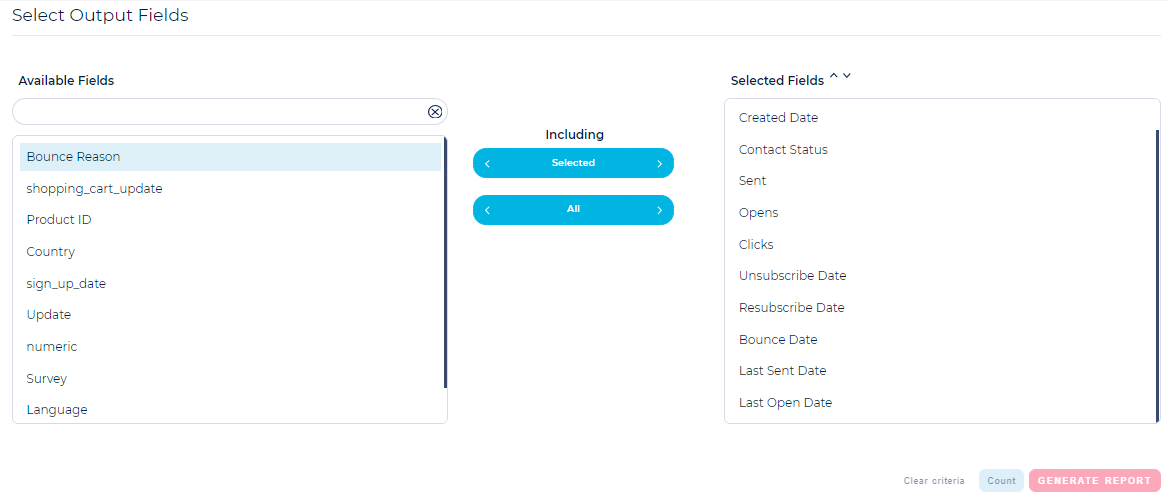
Click on view report and once the report is generated, and it will include a column of the last bounce reason in the CSV report file.
Click on the ‘Export Combined Detailed Report’ as explained in the section above and download the CSV.
In the CSV file downloaded, under the “Type” column you will see the “Soft Bounce” and/or “Hard Bounce” as values for bounced contacts.
For the same contacts, under the “ocx_bounce_reason” column, you can see all the bounce reasons for each contact.
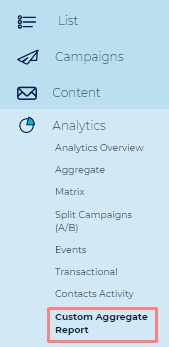
![]() The custom aggregate report is a powerful email marketing analysis report. It enables additional custom grouping, you won't find in the standard aggregate report described above. These groupings (or Pivots if you will), include:
The custom aggregate report is a powerful email marketing analysis report. It enables additional custom grouping, you won't find in the standard aggregate report described above. These groupings (or Pivots if you will), include:
Grouped by List Field. I.e., grouped by values in a List field, e.g., demographics values (for example: state, region, or gender, income, etc.). See details in the following subsection ''List Field Grouping Usage Examples".
This report also enables 2 grouping levels, so for example you can have group by State and by City.
Grouped by All Top Level ISP Domains (e.g., yahoo.com, gmail.com) you're sending to.
This provides for a long-tail of email deliverability and performance analysis.
So while the Matrix Report noted above, displays stats for the top 7, 8 ISP domains you're sending to, this reports provides the full long-tail of all ISP/Mailbox provider domains you're sending to.
Grouped by ESP Connection ID. Use this with the Top Level Domains – you can get a full long-tail Matrix report.
Grouped by All 2nd Level ISP Domains, e.g., yahoo.* for all yahoo domains .com, .uk, etc.
Grouped by Campaign ID. Group this on first level and Email Message ID – offers additional flexibility and insights you won't find in the regular Aggregate Report.
Grouped by Email Message ID.

Let's say you have a list field called source, that indicates the source of each contact (aka lead). Let's say the values there are: SEO, AD WORDS, FACEBOOK, LINKEDIN.
With this report you can then analyze open rates, soft bounce rates, click rates, unsub rates, per source. Enabling marketers to analyze which sources performs best/worst.
Alternatively the source values could have been Affiliate IDs, enabling marketers to analyze which affiliate source performs best/worst.
List Field state. If you capture the State value for each of your contacts, you can then compare delivery and behavioral performance analysis between different regions, and see which ones have the best/worst performance.
If you also capture the city you can compare the performance of different cities grouped by state by using the double grouping feature.
Any demographic data you might collect and want to compare delivery and engagement from Gender to Age, etc.
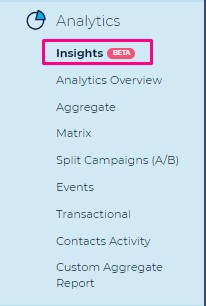
The first Insights (Beta) report was introduced in April 2023. It offers a comprehensive, account level, 12-month view of your email performance, including sends, opens, and clicks, both unique and raw. Color-coded changes, compare results to the past month and year average, make it easy to track progress and declines in a glance. With this new tool, marketing managers can quickly get high-level vital stats of their account, gaining valuable insights into the volumes and performance of their marketing operations.
This initial Beta includes only the first of what will be several insight reports that will become available in this section moving forward.
This report has two tabs, one for for Total and one for Unique Stats.
In the percent change columns color coding from light green to dark green indicate increases in % and color coding of light grey-pink to dark grey-pink indicate decreases in %
Sends – shows total sends for each month
Sends Monthly Change (%) – shows the % change in sending compared to the previous month.
Sends Annual Change (%) – shows the % change in sending compared to the average of the past 11 months.
Opens – shows total opens for each month
Opens Monthly Change (%) – shows the % change in opens compared to the previous month.
Opens Annual Change (%) – shows the % change in clicks compared to the average of the past 11 months.
Clicks – shows total clicks for each month
Clicks Monthly Change (%) – shows the % change in clicks compared to the previous month.
Clicks Annual Change (%) – shows the % change in clicks compared to the average of the past 11 months.
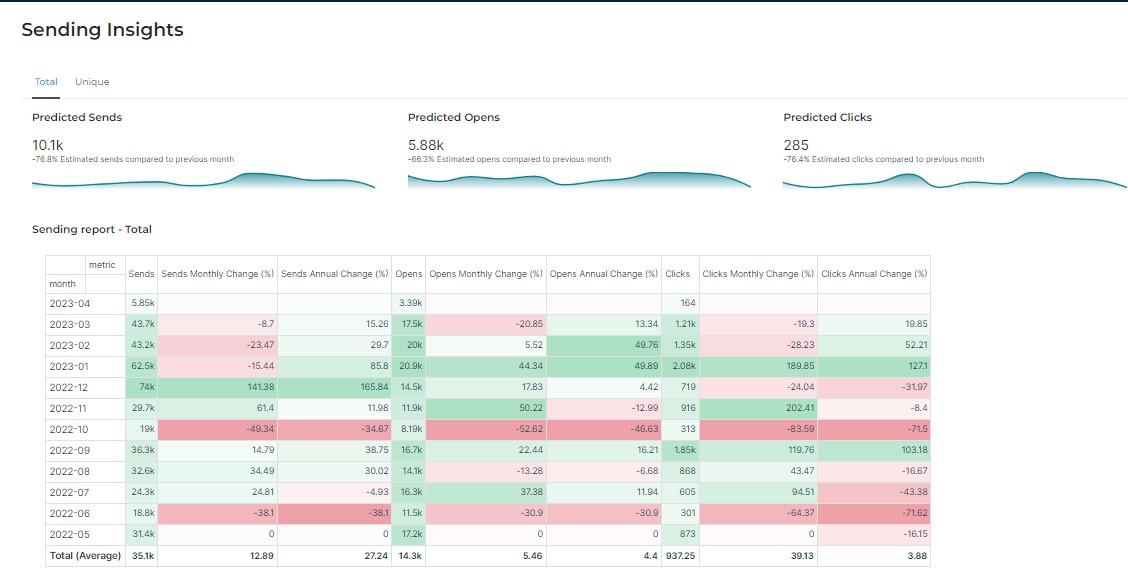
![]() Note: The unique count in this report is per contact / per month and per year (and not per campaign as in other Ongage aggregate reports).
Note: The unique count in this report is per contact / per month and per year (and not per campaign as in other Ongage aggregate reports).
Following are the time intervals that Ongage pulls email delivery stats (statistics) from the outbound SMTP connections:
First hour – every 30 minutes
2-3 hours – every 60 minutes
4-6 hours – every 2.5 hours
7-24 hours – every 6 hours
After that – once a day
![]() Ongage typically pulls all delivery stats (sent, success, failed, hard bounces, soft bounces, complaints) via API calls to the outbound ESP/SMTP plug-in connection.
Ongage typically pulls all delivery stats (sent, success, failed, hard bounces, soft bounces, complaints) via API calls to the outbound ESP/SMTP plug-in connection.
|
![]() Ongage stops retrieving campaign stats after 1 week. Having said that, behavioral data, and in particular soft bounces, hard bounces and complaints, are pushed to Ongage from the outbound ESP/SMTP, and can in theory still come in weeks later, and while they may not be reflected in the campaign stats, those contacts will correctly be marked as hard bounced and complained in Ongage, and their status will become inactive, meaning Ongage will automatically stop sending to them!
Ongage stops retrieving campaign stats after 1 week. Having said that, behavioral data, and in particular soft bounces, hard bounces and complaints, are pushed to Ongage from the outbound ESP/SMTP, and can in theory still come in weeks later, and while they may not be reflected in the campaign stats, those contacts will correctly be marked as hard bounced and complained in Ongage, and their status will become inactive, meaning Ongage will automatically stop sending to them!
In Ongage, stats retrieval for the following SMTPs works in a different model:
Amazon
MySmtp
Private SMTP
These vendors push stats to us, as opposed to the model above where we need to pull those stats in incremental intervals (as detailed above).
![]() Therefore with this latter set of SMTP vendors, the stats are updated continuously back into Ongage. Add to that, data processing time, which can take typically between 10-20 minutes.
Therefore with this latter set of SMTP vendors, the stats are updated continuously back into Ongage. Add to that, data processing time, which can take typically between 10-20 minutes.
Ongage stores stats data for up to 2 years.
By default, the stats date filter only goes back 1 year. You'll need to speak to your account manager in order to enable searching data that is up to 2 years old. Depending on your package, more than one year may not be available.